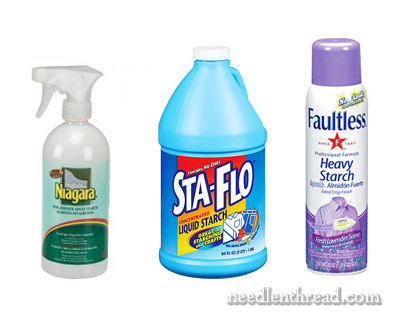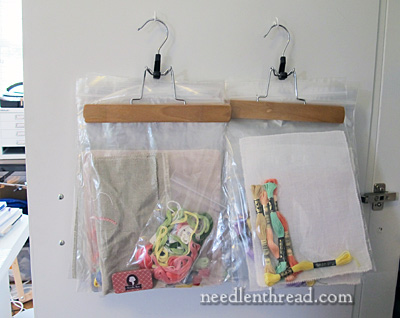Last week when I reviewed the LightPad for transferring embroidery designs, I mentioned that I’ve transferred 52 monograms in the past month-ish. This generated a lot of questions, but the most common one was about the transfer process itself.
What do you use to trace monograms (or any patterns) onto linen, if the monogram is going to be laundered. Should the transfer be permanent? What if you can’t cover it up?…. Lots of questions about tracing designs.
I’m pretty sure I’ve mentioned this tip before on Needle ‘n Thread, but if not, I should have! It deserves its own article, its very own space in cyberspace.

The secret ingredient to tracing a non-permanent design onto linen or cotton that will be laundered or at least rinsed after stitching is Spray Starch.
My preferences are from left to right. I prefer the pump bottle of Niagara starch over aerosol any day, but since it’s only available at one store in a 50 mile radius, I tend to run out of it often. So my next preference is to dilute liquid starch in the empty pump bottle. If I run out of both options, the only spray starch available locally is Faultless in the purple can, which works fine for this, too.
Douse the linen with spray starch, especially on the side you’re drawing on. I always starch both sides before transferring a design, just in case I flip the fabric. Let the fabric sit a minute, and then iron it on the proper setting for the type of fabric it is.
Now you’re ready to trace. Use a regular HB or #2 pencil and trace the design onto the fabric.
When you’re finished stitching, rinse the piece well and damp stretch it. The spray starch will allow the pencil lines to release easily with a good rinsing. Of course, this doesn’t mean you can use a heavy hand and draw deadly dark lines on your fabric, but it works great with regular lines that are clearly visible.
So that’s how I transferred 52 monograms in the last month.

And here they all are, organized and bagged up into their own little kits, ready to stitch!
You can find more information – and many more techniques – on transferring embroidery designs here. Have a look – you’re bound to find a transfer process that will work for you!







Spray starch! Who would have thought it? Thank you so much…
Thank you – so simple a tip and so useful!
Thank you for this great tip and for all the wonderful things you post on your fantastic blog! I really enjoy learning and being inspired by your work.
This is not exactly needlework related, but it is starch related…last night I happened to catch a PBS story about Chatsworth house in England. They were putting on a flower show and the huge (12(?) feet by 30 feet)tablecloth got a stain. Their 2nd tablecloth was brought out and the house keepers were attempting to iron it. It was so starched that they said it no longer felt like fabric, and it crackled when they unfolded it. It was like trying to unfold canvas and it Would. Not. Iron. Flat. They had a fabric conservator in and she said that there was no way to get it smooth due to it being dry and now absorbing moisture from the air and irons unevenly and it was pulling out of shape. The only cure was to send it out for laundering and get the starch out. Those house keepers felt *so* bad about the visitors negative comments about the tablecloth. The other one came back from laundering the next day, nice and soft and fluid and they spend hours re-doing the table again.
Sorry for the babbling, but the starching fabric for tracing made me think of that stiff table cloth. I guess my point is if enough starch can defeat some of the best house keepers in England, it can certainly do the job on a small bit of fabric for tracing.
A BIG Thanks for this one Mary. I’m always in a quandary when it comes to transferring designs. I printed out your “Light Box” submission, as I want to sit down with it and a cuppa coffee. I have a glass coffee table which serves as a great light box when I put a high density light under it !! 😀
My daughter got interested in quilting and after visiting one of our local stores, we found Mary Ellen’s Best Press. We love it. It doesn’t leave your fabric with any residue and it comes in pretty smells. We now order the gallon size from Joann’s (with a coupon) and just refill our smaller pump bottle. I’d be interested to read what you think of it if you get a chance to try it.
Seeing this tip, which I will try, you show your project kit. Do you have any tips on storage for project kits?
Thank you,
Patricia
Mary, I thought I remembered hearing you say not to rely on spray starch to keep pencil lead from becoming permanant. If I’m not remembering right, then I’m happy about this! The idea (that I picked up from someone…possibly not you) was that when stitching, the needle and thread drags the pencil lead into the fabric…making it difficult to remove.
The only embroidery I’ve done when using lead pencil to trace the design, has been when I completely covered the traced design with my embroidery thread anyway…so it isn’t all that important that the lead washes out. My lead pencil tracing is light, usually on white fabric and I’ve never had a problem with using it. Any thoughts?
Where has this secret been all my life? Tremendous tip – Thank you!
I just checked on Amazon and they have Niagara Starch in the pump bottle for sale.
This is probably a no, no, but I spray my pattern with Solvy something or other (it is sticky), then place my fabric on the design and it does not slip. I have never had a problem with discoloring or anything else.
Louise B.
I’m with you in preferring not to use aerosols. There is just no need to be spraying propellant all over the house. Besides, the starch molecules need to be modified for use in aerosol cans, reducing the effectiveness. All of the items you show are available on Amazon if you’re in a pinch, and I just found a few new brands that I’ll order and try out.
Dear Mary
The penny’s finally dropped! I wondered why your linen always looked so crisp and wrinkle-free during stitching. And it helps with transfer design. Who would have thunk it!
Wow! I love your project storage solution! I’ve got everything in bags, but then they are all stuffed into a basket. Hanging them up in my spare closet would be the perfect solution to keep things a little more accessible!
After seeing a “pin” on Pinterest…I have been making my own spray starch with water and corn starch. A small amount of corn starch cooked in a cup of water in the microwave for a minute. Dilute the cooked mixture further and fill the spray bottle. Works great and the cost is very minimal.
Deb
I’m a little concerned with Mosaic Magpie’s cornstarch and water spray starch and the possibility of insects being attracted to the finished embroidery for a snack or two. Washing the project after completion could possibly lessen or eliminate the risk; however, not all embroideries eg 3-dimensional work, isn’t usually laundered.
Hi, Catherine – yes, that’s why I specified using starch just on embroidery that is washed after working. Storing anything that is starched for any period of time is a bad idea – it can also discolor the fabric, cause it to crack or break, etc. I’ve seen it happen with antique linens! Sad! – MC
Can’t believe I didn’t think of this myself! That’s why I started following you Mary ’cause you think of everything. I do alot of quilting and embroidery and had to have the Niagra spray NOW! The cheapest price I found on Amazon was $13.. with a suggested retail price of $32.. I found it at Walmart today for $1.96. How is that possible? It looks and reads like exactly the same product. It doesn’t make any sense. What am I missing?
Mary, love your blog because you always offer something new and fresh. Thank you!
very nice tip. thank you. I am new to your site and love it……will be popping in often to learn from you.
Generally, an HB grade about the middle of the scale is considered to be equivalent to a #2 pencil using the U.S. numbering system.
In reality however, there is no specific industry standard for the darkness of the mark to be left within the HB or any other hardness grade scale. Thus, a #2 or HB pencil from one brand will not necessarily leave the same mark as a #2 or HB pencil from another brand. Most pencil manufacturers set their own internal standards for graphite hardness grades and overall quality of the core, some differences are regional. In Japan, consumers tend to prefer softer darker leads; so an HB lead produced in Japan is generally softer and darker than an HB from European producers.
Finding what works best for your own artistic and writing needs is generally a matter of personal preference and experimentation with different brands of pencils.
So what brand of pencil are you using?